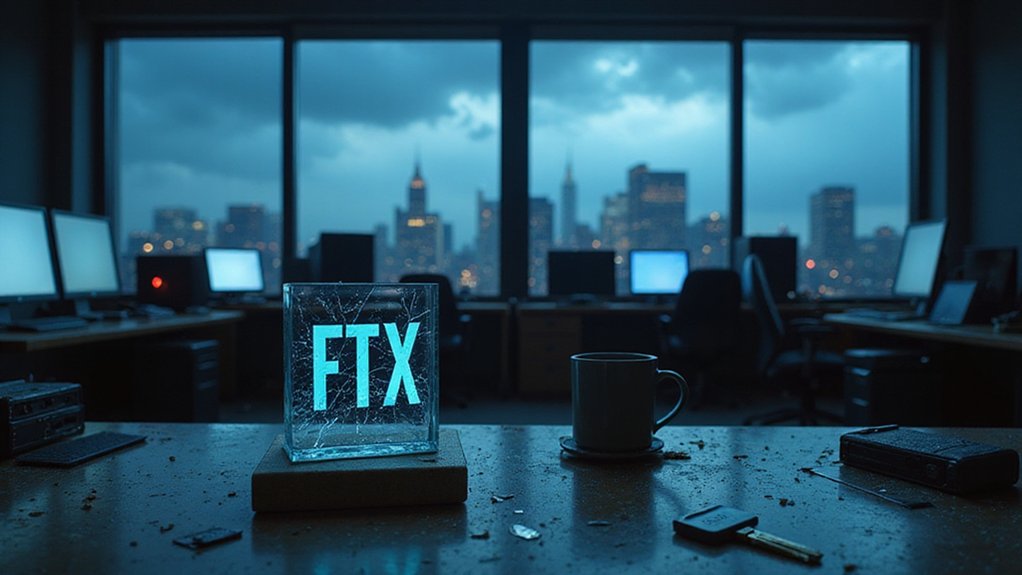FTX, founded in 2019, rocketed to a $32 billion valuation before spectacularly imploding in November 2022. The exchange—helmed by now-convicted fraudster Sam Bankman-Fried—collapsed after revelations of commingled customer funds with sister company Alameda Research triggered a catastrophic bank run. Bankman-Fried’s subsequent 25-year prison sentence and $11 billion restitution order punctuate crypto’s most spectacular corporate failure. The saga continues unfolding as customers await partial recovery of their once-vaporized assets.

The meteoric rise and catastrophic fall of FTX represents one of the most spectacular implosions in modern financial history.
Launched in 2019 as a digital currency exchange platform, FTX rapidly ascended to prominence, achieving a staggering $32 billion valuation by January 2022—a figure that, in retrospect, seems almost comically detached from fundamental reality.
The platform, which facilitated cryptocurrency transactions globally and provided digital wallet services, attracted substantial investments from blue-chip venture capital firms seemingly keen to stake their reputations on the crypto frontier.
FTX’s financial architecture, however, harbored fatal structural flaws.
Beneath the veneer of financial sophistication, FTX concealed catastrophic design defects destined for collapse.
The exchange’s intricate relationship with Alameda Research—a trading firm also founded by Sam Bankman-Fried—created a precarious house of cards underpinned by FTT, FTX’s native token.
This circular financial arrangement (wherein Alameda’s balance sheet was heavily concentrated in an illiquid token created by its sister company) represented a stunning concentration of risk that somehow escaped appropriate scrutiny.
The collapse began with a November 2, 2022 CoinDesk report revealing Alameda’s FTT-laden balance sheet.
When Binance—once an FTX investor—announced the liquidation of its FTT holdings, the ensuing crisis of confidence triggered a classic bank run.
Customer withdrawals accelerated, liquidity evaporated, and bankruptcy proceedings commenced on November 11, 2022.
Adding insult to injury, a suspected hack subsequently drained approximately $477 million from the already-bankrupt exchange.
The Bahamas-based operation, which had benefited from minimal regulatory oversight, subsequently faced intense legal scrutiny across multiple jurisdictions.
Similar to the Mt. Gox collapse that shook cryptocurrency markets years earlier, FTX’s downfall highlighted persistent vulnerabilities in digital asset exchanges.
Bankman-Fried confronted numerous civil and criminal charges while billions in customer assets remained inaccessible.
Those attempting to access information about the defunct exchange may encounter a 404 error, indicating that the official website pages are no longer available.
The debacle reverberated throughout cryptocurrency markets, heightening volatility and intensifying calls for thorough regulation.
Following his conviction in November 2023, Bankman-Fried received a 25-year prison sentence and was ordered to repay $11 billion in restitution to victims.
Two years post-collapse, recovery efforts began yielding partial repayments to affected customers—cold comfort for those whose assets had long been frozen.
The FTX saga stands as a cautionary tale of financial hubris, regulatory blind spots, and the perils of unrestrained innovation unfettered by traditional financial safeguards.
Frequently Asked Questions
How Did Sam Bankman-Fried’s Personal Lifestyle Affect Ftx’s Downfall?
Bankman-Fried’s Jekyll-and-Hyde lifestyle—frugal in public while privately indulging in extravagance—created a catastrophic dissonance that ultimately sank FTX.
His cultivated image of ascetic virtue masked the wholesale misappropriation of customer funds for personal luxuries and Alameda Research’s risky ventures.
This duplicity not only drained corporate coffers but fostered a cultural rot within FTX’s governance where ethical boundaries dissolved, financial controls evaporated, and the inevitable $9 billion shortfall materialized like a self-fulfilling prophecy.
What Happened to Customer Funds Stored on FTX?
Customer funds at FTX became ensnared in a financial morass after the exchange’s November 2022 bankruptcy.
These assets were effectively frozen, with balances immortalized at their pre-collapse values.
While approximately $14.7-16.5 billion has been recovered, the redistribution plan aims to repay customers 118% of their account values—in fiat currency, not crypto.
Small creditors (under $50,000) are prioritized for 2024 disbursements, while larger stakeholders face a potentially protracted waiting game for their financial resurrection.
Could Regulators Have Prevented Ftx’s Collapse?
Regulators could likely have mitigated FTX’s collapse through several interventions.
Stricter oversight might have prevented the commingling of customer funds, while mandatory transparency requirements could have exposed financial irregularities sooner.
The absence of coordinated international frameworks created jurisdictional loopholes that Bankman-Fried exploited with remarkable efficiency.
Regular audits and capital requirements—financial guardrails long established in traditional markets—would have constrained FTX’s risk-taking.
The regulatory failure represents less an oversight than a deliberate policy choice.
How Did Ftx’s Failure Impact Broader Cryptocurrency Adoption?
FTX’s implosion cast a long shadow over cryptocurrency adoption, temporarily decelerating mainstream momentum as institutional investors retreated amid contagion fears.
The spectacular failure—featuring misappropriated funds and governance failures—provided skeptics with potent ammunition while triggering heightened regulatory scrutiny worldwide.
Paradoxically, this regulatory attention may ultimately strengthen the ecosystem’s foundation, as increased oversight could enhance consumer protection and market stability—prerequisites for the broader adoption that crypto evangelists have long prophesied but that remains perpetually just beyond reach.
What Legal Precedents Were Established Through the FTX Bankruptcy Proceedings?
The FTX bankruptcy established several notable legal precedents, particularly the Third Circuit’s ruling that examiner appointments are mandatory under 11 U.S.C. § 1104(c)(2) when statutory conditions are met—interpreting “shall” as non-discretionary.
The proceedings also pioneered frameworks for cryptocurrency valuation in bankruptcy contexts, exploring the uncharted waters of digital asset estimation under Section 502(c).
Additionally, the court’s approval of a complex reorganization plan with novel settlements may serve as a template for future crypto-exchange insolvencies.









